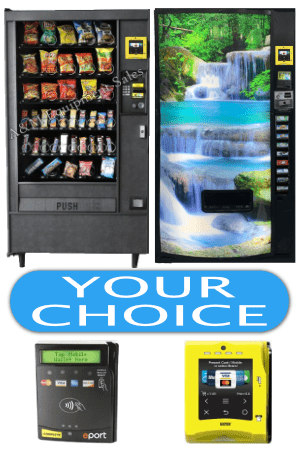Vending Efficiency Operating Procedures An interview with Larry Towner, vending consultant
In this podcast, Larry discusses: Vending Efficiency Operating Procedures
- Storing product
- Statistically you touch an item 5 times before it sells
- Create a plan for loading your truck so that you get a smooth flow of products
- Loading drinks vs. loading snacks
- Keeping things neat and orderly makes you more money
- Dealing with products going out of date in the warehouse
- Use vertical space to your advantage
- Eliminate confusion
\
EPISODE TRANSCRIPT:
Tom: I’m Tom Shivers with the Vending Business Show here with Larry Towner who is a vending business consultant. He’s been in the vending business for a long time so thanks for being here Larry.
Larry: Thanks Tom, appreciate it.
Tom: In the last show, past couple of shows, we’ve talked about some interesting topics like marketing at the machine level and product turn. Basically, at this point, in the process, the vending operators may be selling more product. I imagine Vending Efficiency Operating Procedures is, becomes kinda important at this stage.
Larry: Yeah, it’s kinda time to start talking about Vending Efficiency Operating Procedures because now that you’ve got everybody selling product at a strong level, a couple of different problems that come up, everybody thinks oh it’s great to sell a whole lot of product, that’s great I’ll be making all this money except there’s a couple of things people don’t realize when they get out to selling a lot of product that, kinda like where do you keep it? And how do you move it? And a few things like that and so one of the things that we’ll start with, and there’s a series of shows that’ll go on talking about operations and efficiency and things like that, but one of the things that or where we’ll start is basically in your warehouse operation. And Tom, where do you think most people start in the vending business if they have a start a vending company? Do you they start with the-
Tom: Probably in the garage.
Larry: Yeah, probably in the garage is right. Or maybe just out of the truck and they use Sam’s club or one of the other warehouse clubs as their warehouse and that’s actually a great way to start but eventually you’ll get to the size where you need to start storing up a little product and usually everybody tends to move to their garage.
Larry: A couple of things about your garage. First off is, if you are married or you have a significant other or whatever, they general don’t like their garage full of snack food and drinks and things like that so it can lead to some tense moments in the family life and one has to just be aware that that might happen. But when you set your warehouse up and it really doesn’t matter how big your warehouse is, but you wanna have your, kind of your mind on efficiency and how do you move product easily.
Larry: One thing that we’ve done through statistics and things like that is that we’ve found that when we take products and from the time we receive a product to the time a product goes into the customer’s hands, we have actually handled it five times. And that’s an awful lot of moving of product if you think about it. If you’re gonna do some significant volume, if you say move a 100,000 items a year, you’ll have touched those items 500,000 times a year because you’ll have touched them five times.
Larry: So if you can remove one of those steps out of there, that’s say 400,000 times that you touch everything instead of 500 and that will lead to more profitability down the road. When you go in to laying your warehouse out, and this can be as simple as your garage, or it can be as complex as a very large drive in warehouse where you’re gonna be loading multiple trucks at any given time, you kinda wanna have a plan as to how you load your truck and subsequently your combines with your truck. Which your truck then should combine with your machines so that everything has a very smooth flow to it and that keeps you from having handle things too many times.
Larry: So I always say first off, in the vending business we have two basic types of products. We have drink products and we have snack products and those two things. What’s the difference between those two, Tom?
Tom: One is liquid and the other one’s not.
Larry: That’s correct. And the difference is, tell me a little bit about the weight of each of those items.
Tom: Well the drink’s gonna weigh more than the snack.
Larry: Absolutely. And the drinks are much, much, probably 400 times heavier, I don’t know the exact number but it’s quite a bit so when we go to lay out a warehouse, we always try to set. For me anyway, I always try to set drinks where they’re essentially at truck level when I bring ’em in. I try to set my warehouses up where I can back the bumper of the truck up to ground level and we can move things into the truck without having to lift them up and you’ll understand that if you get into the vending business and you go to load a hundred cases of drinks every day and you have to load ’em up three feet into your truck every day versus just rolling ’em straight across the dock plate or something like that.
Larry: Now that’s tough to do when you’re in your garage but you can set up a ramp system and you can make a kind of removable thing where you can actually roll your drinks up on a hand truck, into your truck, from the ground. And these are little things, but at the end of a long day, when you go to load your truck or the beginning of a long day, just depending on how you set up your particular route, these little things make a big difference as to how tired you are and how much extra work you can actually do.
Larry: We always set our drinks on the ground. We generally try to put them on pallets because what my goal was is, that even in a garage type situation, I put it on a pallet, I invested the money in a pallet jack because if I took my drinks, I could actually take a whole pallet and pull it right over to the back of the truck and load from the pallet into the truck. It makes it much, much easier, must faster, and then you can roll the pallet back and put it back where it goes because keeping things neat and orderly is what’s gonna help you make extra money.
Larry: If you go into a UPS warehouse or something like that, you’ll find a huge automated system that keeps things tracked and itemized and inventoried and in the vending business, Tom, what’s one thing about vending products that you know that’s critical in a vending product, they all have something printed on them, what’s that that’s printed on every vending product?
Tom: The date. Or UPC code.
Larry: There’s an expiration date. Yes. And the basic problem with expiration dates is, is that when that expiration date arrives, you need to throw that product away or eat it either way but it’s no longer sellable as of the expiration date. And one of the things that always, always, always when I ran my businesses or I run my businesses I should say that absolutely infuriates me is to have product go out of date sitting in the warehouse and believe it or not, it happens in every company and it happens because people try to cut corners so you have to have a flow system where the old date product, the longest purchase to go gets put on the truck first and this is done by good organization, making sure you can see all of your product, don’t have any place where product can fall down behind other product or get hidden by other boxes and when you go and you purchase product, make sure you move the old inventory up and push the new inventory to the back. Sounds simple but you’d be amazed how much it doesn’t happen.
Larry: And one other thing when we go to lay out a warehouse and particularly in a garage type situation, you really wanna make sure you use vertical space. And when I say that invest in some shelving or build some shelving, either way, it doesn’t really matter but get some shelving. You can good, inexpensive shelving. Pallet racks work really well. They’re very, very inexpensive and you can stack your products up vertically. Drinks always go on the ground ’cause they’re heavy and you really don’t wanna be lifting drinks but your snack products can go all the way to the ceiling ’cause they just don’t weigh anything. A box of chips only weighs, I don’t know not even a pound and anybody can pick up a box of chips, including women.
Larry: So that’s just some little tips. The organization of it is, is that when you go from your warehouse into your truck, you wanna have a flow. You wanna have everything in the same place and we always organized our warehouse the same way we organized our trucks, which in turn, was dependent on how our planograms were set up in the machines, meaning, as we talked about in the last show when we were marketing at the machine level, we had certain things in certain places. We then took, we worked our way backward from the machine level to the truck. When you walked into one of our trucks on the shelves, it looked just like the machine. The top shelf stuff was on the top shelf. The middle shelf and so forth and so on down the shelf so when you walked up to that machine and you wrote down you needed six of this and six of that and six of this and six of that, you went into that truck and the truck was exactly the same way, where the top shelf had all those products and the middle shelf.
Larry: And then, at the end of the day, or the beginning of the day depending on when you load, you go into the warehouse, everything is in the same place there as well so you’re never confused because you put something in the wrong place. Does that make sense?
Tom: That’s great stuff, Larry. Thanks for sharing. Tell us a little about your consulting business.
Larry: Well, we do consulting. We give these kinds of tips and more out to the various people that are particularly start up companies or companies looking to the make step in vending that are looking to move up and do more in the vending business but startups are really who need the most help. We can be reached at [email protected] and just drop us an email and we’ll see if we can get together and possibly help you out.
Tom: You’ve been listening to Vending Efficiency operating Procedures at the Vending Business Show, a publication of A & M Equipment Sales. More Videos to look at FDA Requirements for Vending Machines: What You Need to Know



